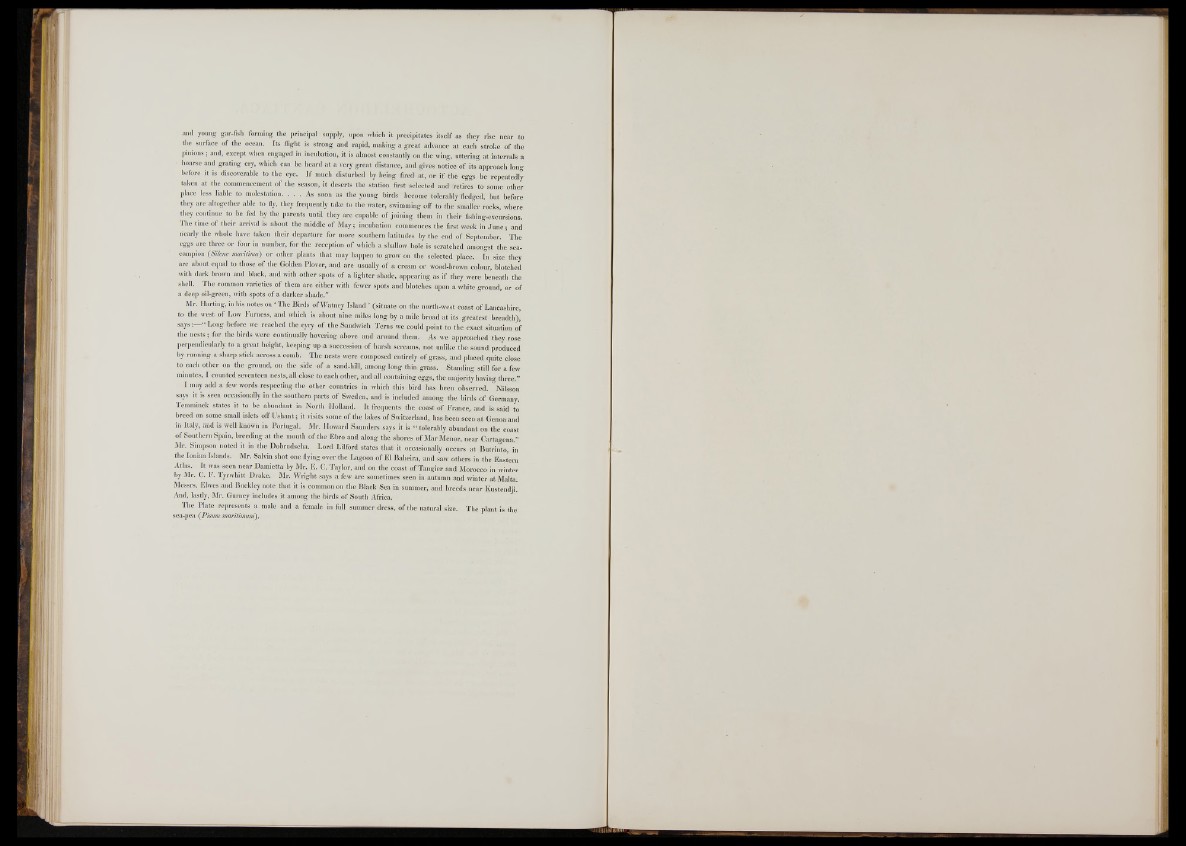
and young gar-fish forming the principal supply, upon which it precipitates itself as they rise near to
the surface o f the ocean. Its flight is strong and rapid, making a great advance at each stroke o f the
pinions ; and, except when engaged in incubation, it is almost constantly on the wing, uttering at intervals a
• hoarse and grating cry, which can be heard at a very great distance, and gives notice o f its approach long
before it is discoverable to the eye. I f much disturbed by being fired at, or if the eggs he repeatedly
taken at the commencement o f the season, it deserts the station first selected and retires to some other
place less liable to molestation. . . . A s soon as the young birds become tolerably fledged, but before
they are altogether able to fly, they frequently take to the water, swimming o£f to the smaller rocks, where
they continue to be fed by the parents until they are capable o f joining them in their fishing-excursions.
The time of their arrival is about the middle of May; incubation commences the first week in June; and
nearly the whole have taken their departure for more southern latitudes by the end o f September. The
eggs are three or four iu number, for the reception of which a shallow hole is scratched amongst the sea-
campion ( Silene marítima') or other plants that may happen to grow on the selected place. In size they
are about equal to those of the Golden Plover, and are usually o f a cream or wood-brown colour, blotched
with dark brown and black, and with other spots of a lighter shade, appearing as if they were beneath the
shell. The common varieties of them are either with fewer spots and blotches upon a white ground, or of
a deep oil-green, with spots of a darker shade.”
Mr. Harting, in his notes on • The Birds o f Watney Island ' (situate on the north-west coast o f Lancashire,
to the west of Low Furness, and which is about nine miles long by a mile broad at its greatest breadth)!
s a y s “ Long before we reached the eyry o f the Sandwich Terns we could point to the exact situation of
the nests; for the birds were continually hovering above and around them. As we approached they rose
perpendicularly to a.great height, keeping up a succession of harsh screams, not unlike the sound produced
by running a sharp stick across a comb. The nests were composed entirely of grass, and placed quite close
to each other on the ground, on the side o f a sand-hill, among long thin grass. Standing still for a few
minutes, I counted seventeen nests, all close to each other, and all containing eggs, the majority having three."
I may add a few words respecting the other countries in which this bird has been observed. Nilsson
says it is seen occasionally in the southern parts of Sweden, and is included among the birds of Germany.
Temminck states it to be abundant in North Holland. It frequents the coast o f France, and is said to
breed on some small islets off Ushant; it visits some of the lakes o f Switzerland, has been seen at Genoa and
in Italy, and is well known in Portugal. Mr. Howard Saunders says it is ■* tolerably abundant on the coast
o f Southern Spain, breeding at the mouth of the Ebro and along the shores o f Mar Menor, near Cartagena.”
Mr. Simpson noted it in the Dobrudscha. Lord Lilford states that it occasionally occurs at Butrinto, in
the Ionian Islands. Mr. Salvin shot one flying over the Lagoon o f El Baheira, and saw others in the Eastern
Atlas. It was seen near Damietta by Mr. E. C. Taylor, and on the coast of Tangier and Morocco in winter
by Mr. C. F. Tyrwhitt Drake. Mr. Wright says a few áre sometimes seen in autumn and winter at Malta.
Messrs. Elwes and Buckley note that it is common on the Black Sea in summer, and breeds near Kustendji.
And, lastly, Mr. Gurney includes it among the birds o f South Africa.
The Plate represents a male and a female in full summer dress, o f the natural size. The plant is tile
sea-pea (Pisum maritimum).